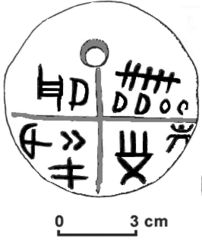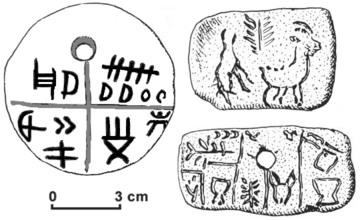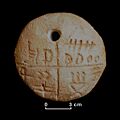Tărtăria tablets facts for kids
The Tărtăria tablets are three small clay tablets. They were reportedly found in 1961 at an ancient site in a village called Tărtăria in Romania. This village is about 30 miles (48 km) from Alba Iulia, in a region called Transylvania.
These tablets have special symbols carved into them. These symbols are similar to others found from the Vinča culture. Many archaeologists have debated about these symbols. Some believe they might be the oldest form of writing ever found in the world. It's hard to know the exact age of the tablets. This is because how they were found is debated. Also, they were baked after being found, which stops scientists from using a special dating method called radiocarbon dating directly on them.
Some scientists think the tablets are from around 5300 BC. This would make them older than the first picture-based writing from Mesopotamia. However, some experts question if the tablets were truly found where it was reported. They suggest the tablets might have come from a newer layer of the site. Other experts believe the Tărtăria symbols might be connected to early Mesopotamian writing, like Sumerian proto-cuneiform.
Contents
How the Tablets Were Found
In 1961, a team led by archaeologist Nicolae Vlassa made an important discovery. They reportedly dug up three clay tablets that had not been baked yet. These tablets had symbols carved into them. They also found 26 clay and stone figures, a shell bracelet, and the bones of an adult female. This woman is sometimes called "Milady Tărtăria."
People don't fully agree on what the burial means. But some think the woman might have been a respected wise person, a shaman, or someone who could talk to spirits in her community.
Doubts About the Discovery
There are some questions about whether the tablets were truly found at the reported site. Nicolae Vlassa, who led the team, never fully explained how they were found or the layers of earth they came from.
Some people also question if the carvings on the tablets are real. A recent idea suggests they might be fake. This idea comes from how similar some of the symbols look to Sumerian symbols. These Sumerian symbols were shown in popular Romanian books when the tablets were found.
What the Tablets Look Like
Two of the tablets are shaped like rectangles, and the third one is round. They are all quite small. The round tablet is only about 2.5 inches (6 cm) wide. Two of the tablets, the round one and one of the rectangular ones, have holes drilled through them. All three tablets have symbols carved on only one side.
The rectangular tablet without a hole shows a horned animal, a figure that is not very clear, and a plant design like a branch or a tree. The other tablets have many different kinds of symbols, mostly abstract shapes.
How Old Are the Tablets?
Workers at the Cluj museum baked the clay tablets to help preserve them. This made it impossible to use the carbon-14 method to directly find out their age.
Most experts believe the tablets belong to the Vinča-Turdaș culture. This culture was first thought to have started around 2700 BCE. The discovery of the tablets got a lot of attention. This is because they seemed to be older than the first known writing in Europe, which was from the Minoan civilization.
Later, other items found at the Tărtăria site were dated using radiocarbon dating. Based on these dates, scientists now think the site, and possibly the tablets, are from around 5500 BCE. This is around the same time as the early Sumerian civilization in Mesopotamia. However, some evidence from the layers of earth where they were found seems to disagree with this date.
It has been argued that if these symbols truly are a form of writing, then writing in the Danubian culture would be much older than the first Sumerian cuneiform or Egyptian hieroglyphs. This would make them the oldest known writing in the world.
Historical Ideas
The Danubian Culture Idea
The term "Danubian culture" was used to describe the first farming societies in central and eastern Europe. Many experts support the idea that writing might have appeared in this area.
Possible Links to Sumerian Culture
Some people, like Colin Renfrew, think that the symbols on the Tărtăria tablets only look similar to Sumerian symbols by chance. He said that simple picture symbols, like a sign for a goat, will look similar in different cultures. He doubted that these Balkan signs were "writing" in the sense that they could share meaning with someone without talking.
Other Similar Finds Nearby
Artifacts with Vinča Symbols
The Vinča symbols have been known for a long time. They were first found in the late 1800s by Zsófia Torma. She excavated an ancient site called Turdaș in Transylvania. This site is important for understanding the Tordos culture, which was a later part of the Vinča culture.
Other Artifacts Found
The Tărtăria tablets and other items found there are connected to cultures around the Black Sea and Aegean Sea. Similar items have been discovered in Bulgaria, like the Gradeshnitsa tablets. Also, the Dispilio Tablet was found in northern Greece. The materials and style of the Tărtăria items are similar to those used in the Cyclades area. For example, two of the small statues are made of alabaster.
What Do the Symbols Mean?
No one knows for sure what the symbols mean, if anything. Their purpose has been a big topic of discussion.
Are They a Writing System?
Experts who think the symbols are writing make a few assumptions:
- Similar symbols found on other items from the Danube civilization suggest that people used a set of standard shapes.
- The symbols are very organized and have straight lines, similar to early writing systems.
- Each symbol might have had a clear and specific meaning.
- The carvings are arranged in lines, either across, up and down, or in a circle.
If these symbols are indeed a form of writing, we don't know what kind of writing system it is. Nicolae Vlassa thought one tablet showed a hunting scene. He believed the other two tablets with signs were a type of early writing, like the first picture-based writing of the Sumerians. Some archaeologists, like Marija Gimbutas, believe they are parts of a system called the Old European Script.
Are They Non-Linguistic Signs?
One challenge is that there's no clear proof that people in the Balkans could read and write during this time. It's very hard to prove if a group of symbols is a writing system just from archaeological finds. The first known writing systems were created by early states to keep records in complex societies. There is no evidence of organized states in Europe during the Neolithic period. So, it's unlikely they would have needed writing for administration.
Some experts suggest the symbols might have been used for rituals or to mark ownership. Another idea is that they might have been simple copies of symbols from more advanced cultures. However, this is unlikely because the tablets are so old. There were no known cultures with writing at that time from which these symbols could have been copied.
Others think the picture symbols are just mixed with random scribbles.
See also
- Gradeshnitsa tablets
- Dispilio Tablet
- Sitovo inscription
- Prehistoric Romania
- Prehistory of Transylvania
- Cucuteni–Trypillian culture
Images for kids







